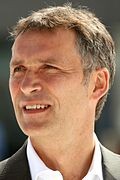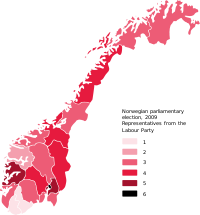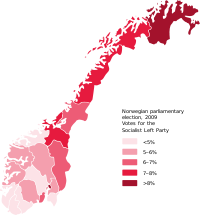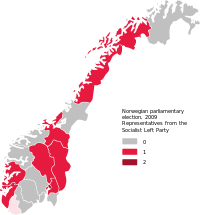- Norwegian parliamentary election, 2009
-
Norwegian parliamentary election, 2009 
2005 ←
members14 September 2009 → 2013 All 169 seats to the Norwegian Parliament
85 seats were needed for a majorityFirst party Second party Third party 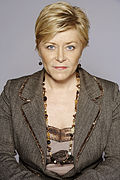
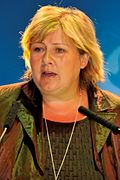
Leader Jens Stoltenberg Siv Jensen Erna Solberg Party Labour Party Progress Party Conservative Party Leader since 10 November 2002 2006 2004 Last election 61 seats (32.7%) 38 seats (22.1%) 23 seats (14.1%) Seats won 64 41 30 Seat change +3 +3 +7 Popular vote 949,060 614,724 462,465 Percentage 35.4% 22.9% 17.2% Fourth party Fifth party Sixth party 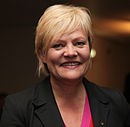
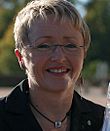
Leader Kristin Halvorsen Liv Signe Navarsete Dagfinn Høybråten Party Socialist Left Centre Christian Democrats Last election 15 seats (8.8%) 11 seats (6.5%) 11 seats (6.8%) Seats won 11 11 10 Seat change -4 0 -1 Popular vote 166,366 165,014 148,750 Percentage 6.2% 6.2% 5.5%
Prime Minister before election
Jens Stoltenberg
Red-Green CoalitionPrime Minister-designate
Jens Stoltenberg
Red-Green CoalitionNorway 
This article is part of the series:
Politics and government of
NorwayMonarchyGovernmentParliamentLocal Gov'tForeign policy
The 2009 parliamentary election was held in Norway on 14 September 2009.[1] Elections in Norway are held on a Monday in September, usually the second or third Monday, as determined by the king.[2] Early voting was possible between 10 August and 11 September 2009,[3] while some municipalities held open voting on 13 September.[1] Voters elected 169 members for the Storting,[4] each for a four-year term.[5] Voter turn-out in the 2009 general elections was 76.4%.[6]
Candidates were elected on party lists in each of the 19 counties. The political parties nominated candidates for these lists during late 2008 and early 2009. The party lists had to be registered by 31 March 2009.[7]
Although the opposition received more votes, the governing Red-Green Coalition obtained more seats in parliament. This allowed Jens Stoltenberg to continue as prime minister. Further to the right, both the Conservative Party and Progress Party increased their number of seats in parliament.[8] The centrist Liberal Party failed to meet the electoral threshold of 4.0%, and were reduced to two representatives in Parliament.[9]
Contents
Pre-Campaign
Proportional representation system
There are 169 seats in the Norwegian Parliament, but voters directly elect only 150 as constituency representatives, while the remaining 19 are "at-large" members—one for each county—and these are apportioned to parties based on the total national vote.
For the purposes of parliamentary elections, Norway is divided into 19 constituencies corresponding to the counties, including the municipal authority of Oslo, which is a county of its own. The number of members to be returned from each constituency varies from 3 to 16, according to the population and area of the county. Norway has capped the number of "fixed" seats at 150 and, to determine how to apportion those amongst the 19 counties, it uses a two-tier formula based on population and geographic size. Each inhabitant counts one point, while each square kilometer counts 1.8 points.[2]
Speculations
By early 2008, the Norwegian media were already speculating about possible outcomes of the election, and politicians were making statements about their preferred coalition partners. No single party has had a majority in the Norwegian parliament since 1961, and the largest party in the previous election won only 61 of the 169 seats.[10] The overwhelming likelihood was therefore that the election would lead to the formation of a majority or minority coalition government; the Norwegian Labour Party was the only one likely to be able to form a single-party minority government.[11]
Liberal Party leader Lars Sponheim said during a televised debate in early 2008 that the ruling Red-Green coalition government would face the same problems as Kjell Magne Bondevik's second coalition government. He added that the Red-Green coalition was losing its "faith in the continued majority. It does something to you and your desire for power".[11] In an opinion poll in December 2008, 55% of the Norwegian people had most faith in the Red-Green Coalition government to lead Norway out of the financial crisis.[12]
Campaign
Labour
According to various opinion poll measurements, by late 2008 the Norwegian Labour Party was no longer the largest party in Norway.[13] The Norstat poll for the Norwegian Broadcasting Corporation (NRK) showed the Progress Party at 30.6%, while the Labour Party had declined to 26%. By September 2008 Labour had increased to 29.5%, while the Progress Party decreased to 29.2%.[14] By early September, an opinion poll by Synovate put the Labour Party at 33.8%, while the Progress Party had continued to decrease to 21.4%.[15]
After announcing their plans to tighten national immigration policy, the Labour Party gained a further 2.5% in an opinion poll done by In Fact for Verdens Gang, while the Progress Party decreased by 1.8%.[16] Two out of three Norwegians claimed that they agreed with the new "tightening" of the immigration policy.[17] Later, in a controversial statement, Labour Party secretary Raymond Johanson said "Siv Jensen is the biggest threat to the Norwegian oil industry", claiming thst the Progress Party's oil drilling policy in Lofoten would be a mistake.[18]
Prime Minister and leader of the Labour Party Jens Stoltenberg stated that Labour would campaign for a renewed majority for the ruling Red-Green Coalition, consisting of Labour, the Socialist Left and the Centre Party.[19] The consequences were less clear if the ruling coalition were to lose its majority—the coalition was unlikely to remain in power as a minority government. The Norwegian newspaper, Verdens Gang claimed in March 2008 that the Labour Party could form a minority government on its own if the ruling coalition should lose its parliamentary majority. The county mayor of Sør-Trøndelag, Tore O. Sandvik, was quoted as supporting this option.[19] During a debate, however, Stoltenberg said that a non-socialist majority would yield a non-socialist government.[20]
The Labour Party gathered 35.4% of the popular vote, which was an increase of 2.7% and resulted in three additional seats in parliament. This led to the continuation of the Red-Green Coalition government.[6] After the election, many opposition leaders believed that the government would collapse because of the Labour Party constantly riding roughshod over their coalition partners.[21] In an opinion poll in November, two months after the election, all parties continued to decrease, leading many to speculate that the coalition was "slipping".[22]
Progress
The Progress Party's One Hundred Days Plan was officially announced in August, 2009 in Trondheim. It said that the party wanted to increase "freedom of choice in all public services", making businesses "the most competitive in Europe and restoring confidence in Norway".[23] Per Sandberg, deputy leader of the Progress Party's Sør Trøndelag chapter, blamed the One Hundred Days Plan and said; "The debate on our 100-day program laid out disappointingly fast. We can only lash ourselves to the all-time run".[24]
Progress Party leader Siv Jensen stated that her party would not support a coalition government in which it did not participate, thus apparently ruling out a minority coalition of the Conservatives, the Liberals and the Christian Democrats, like the government of Kjell Magne Bondevik which was in office from 2001 to 2005. She also stated that the Progress Party would have been prepared to form a minority government alone if the party won more seats in parliament than the other three non-socialist parties.[25]
In the months before the election, the party had, as in the 2001 election, received very high poll results that steadily declined throughout the last weeks. In certain individual polls in late 2008, the party averaged around 30%, which at that point made it the most popular party in Norway,[26] Hence the actual election result was relatively disappointing. During the election campaign in the four weeks before the election, the party dropped 3.5% in the poll. Most of these losses went to the Conservative Party, which had run a successful campaign.[24] The Progress Party increased its share of the vote by 0.9%, a slight gain from the previous election and the best election result in the party's history.
Conservative
In the previous election, the Conservatives had their worst result since the Second World War, only obtaining 14.1% of the vote.[27] According to various opinion polls, most notably by Norstat, they had several weak showings from May to July 2009,[14] in what Verdens Gang described as the "summer nightmare". After this, In Fact, an opinion poll service, announced that the Conservatives had scored 15% in their poll.[28]
In January, Conservative Party deputy leader Per-Kristian Foss said that the party would not sit in a government without Erna Solberg as prime minister and claimed that both the Christian Democrats and the Liberals agreed with this policy. On hearing of this, Christian Democrat Party leader Dagfinn Høybråten, said that it would be natural to clarify this when the voters had had their say, but "the negotiations don't start now".[29] After seeing the Progress Party's One Hundred Day Plan, Erna Solberg said "So I conclude that the 100-day revolution is canceled", with the two centre parties distancing themselves more from the Progress Party.[30]
Both the Christian Democrats and the Liberals openly supported a three-party coalition with Solberg as Prime Minister. A new Christian Democrat–Liberal–Conservative government would have avoided the need for support from the Progress Party, by leaving the draft budget from the Red-Green Coalition unchanged. This budget would then pass with support from the Red-Greens and the new non-socialist government. Further issues could then be postponed until 2010 and be handled individually. The Progress Party had promised to vote for measures with which they agree, and the Red-Green parties were expected to do the same.[31] By the start of September, the Progress Party had lost 4.9% of its public support, and many believed that this was due to their One Hundred Day Plan. Meanwhile, the Conservative party gained 3.7%, many of whom were former Progress Party supporters.[32]
The Conservative Party obtained 17.2% of the vote (462,465 votes), an increase of 3.1%, earning 30 seats in parliament, 7 more than the previous election.[6] After a "disastrous" election by the Liberal Party, its leader Lars Sponheim blamed Solberg for the bad results, accusing her of "tearing the party apart". Solberg responded with "He can't honestly believe that having political differences is to tear apart the Liberal Party".[33]
Socialist Left
Facing a steady decrease in support since they joined the Red-Green Coalition, the Socialist Left Party faced the prospect of one of their worst elections since the 1980s. In the 2007 local elections, their result was halved from that of the previous local elections held in 2003.[34] By May 2009, the Socialist Left was the only party in the Red-Green Coalition whose public support increased—they averaged about 11.1% in an opinion poll.[35]
Following a severe downturn, the party improved by late August, averaging around 10% in various opinion polls. At the same time, support for the two other members of the Red-Green Coalition decreased. According to the national newspaper Dagbladet, Socialist Left's rise in popularity was due to the stands they took on environmental issues, the most important of which was oil drilling in Lofoten.[36]
During the campaign, Socialist Left Party leader Kristin Halvorsen was the target of much criticism because, during the 2005 parliamentary election, she said "I will remove poverty with a stroke of a pen". She failed to fulfil this promise, and poverty increased nationwide. Jens Stoltenberg said "Kristin has been a driving force to combat poverty, especially among children. But we are not satisfied, and should do more".[37]
On September 12, the party suffered another decrease in public support, averaging 7% according to various polls. On the same day, two days before election day, party leader Halvorsen started the "24 hours – 24 measures" campaign to build up public support before the election. The Norwegian newspaper Aftenposten said in one of its articles that Socialist Left was involved in an "election massacre", saying there was little hope of increasing public support in the last two days.[38]
On election night, the party lost four seats and were left with eleven, but a three-seat gain by the Labor Party secured the Red-Green coalition a majority in Parliament. The shift of power within the coalition resulted in Socialist Left losing one cabinet minister, leaving them with four, the same as the Centre Party. They ceded the influential Department of Finance to the Labour Party in order to keep control of the Department for Education and Research.[39]
Centre
During the election, the Centre Party faced losing its core voters, the farmers, because Finance Minister Kristin Halvorsen wanted to introduce higher taxes on farming, which the farming community said would lead to high unemployment. Socialist Left MP Heikki Holmås said there was no proof of high taxation leading to more unemployment.[40] In a later statement, Transport Minister Liv Signe Navarsete admitted that she had not "been able to reduce the income gap between farmers and other income groups", saying it would be an issue she would discuss with the Labour and Socialist Left parties.[41]
When the results were announced, the party received a 6.2% share (165,014 votes), a decline from 6.5%. This entitled them to as many Cabinet members as the Socialist Left, whose share of the vote had fallen from 8.8% to 6.2%.[6][42]
Christian Democratic
According to election analysts, the Christian Democratic Party was able to win more votes because of its strong opposition to the Marriage Act of 2008, which gave gay people the right to marry. They believed that same-sex marriage would damage children's upringing, and party leader Dagfinn Høybråten claimed that marriage is primarily for a man and a woman.[43]
During the[which?] national convention, Høybråten made a speech attacking the Red-Green Coalition. His most important message was an attack on the market economy and consumer thinking in Norway.[44] In a later statement, Høybråten said "I challenge those on the Right who have conservative values, those who are not so concerned about dollars, cents and calculators". He later admitted it would be hard to work with the Conservatives if they won the election.[45]
A major problem facing the party was that it lost right-leaning christian voters to the Progress Party. Many of these voters believed that the party would not be able to defend "christian traditions" in Norway, because of its strong opposition to a government run by the Progress party. Another problem facing the party was that it was unable to refresh its image among voters.[46]
Høybråten stated that his party would not be part of a coalition with the Progress Party, but had not ruled out supporting such a government.[47] The Christian Democrats' preference for a coalition was with the Liberals and the Conservatives.[48] In total, the Christian Democrats were able to gather 5.5% of the vote, a decrease from the 6.7% achieved in the 2005 election. After the announcement of their results, Deputy Leader Inger Lise Hansen sparked unrest within the party. She felt that it had become too "narrow" and wanted it to return to the "generous and popular image" it enjoyed during the 1990s. Another faction within the party wanted Høybråten to resign as party leader.[49]
Liberal
The leader of the Liberal Party, Lars Sponheim, stated in September 2007 that his party would neither be a part of nor support a coalition that included the Progress Party, and that the Liberal Party preferred Labour Prime Minister Jens Stoltenberg over Progress Party leader Siv Jensen.[50] By late August, 2009 figures produced by Respons suggested that only 2% within the Liberal Party wanted to collaborate with the Progress Party.[51] Sponheim later distanced himself and his party from the Conservative Party because the Conservatives wanted to improve relations with the Progress Party, leading Sponheim to comment "A vote for the Conservatives is a vote for the Progress Party". He said that the Liberal Party was the only solid choice on the right that didn't want to be involved in a government with the Progress Party.[52]
During a national broadcast debate on TV2, Sponheim said that, if the Progress Party won the minority government position, he would propose a motion of no confidence in the new cabinet.[53] If that did not work, the Liberal Party would support a minority government led by Stoltenberg and the Labour Party.[54] The Norwegian media criticised Sponheim for being very vague and unclear when it came to the Progress Party, and the Red-Green Coalition were unsure of what side he was actually on.[55]
In early September, election researcher Frank Aarebot predicted a catastrophic election for the Liberal Party. The main reason for his prediction was Sponheim's policy of merging various small municipalities into larger and more efficient ones. Centre Party leader Liv Signe Navarsete called this proposal undemocratic and said that forced mergers would only make matters worse.[56]
On the evening of 14 September 2009, Lars Sponheim announced that he would step down as party leader, as a consequence of the results his party achieved.[57] The Liberal Party finished below the 4% threshold for leveling seats, leaving the party with only two seats in parliament, whereas they had ten seats before the election.[58] Sponheim later blamed the Conservative Party for the bad results that hit the Liberal Party and centre politics in Norway.[59] Later still he revealed that he and Stoltenberg were planning to include the Liberal Party in the ruling coalition. Liberal Deputy Leader Ola Elvestuen was negative towards the idea, saying that the only option for a coalition was with the Christian Democrats and the Conservatives.[60]
Red
The Red Party was established by a merger of the Red Electoral Alliance and the Workers' Communist Party in 2007. Torstein Dahle, the leader of the Red Electoral Alliace, was elected party leader.[61] In the 2007 county election, Red received 1.9% of the vote, increasing its share by 1.6%.[62] In an opinion poll conducted by TNS Gallup for TV2 in late August 2009, the party received 2.7% of the popular vote, an increase of 0.7%. Such a result in the election would mean that the party would have two parliamentary representatives, one from Oslo and one from Hordaland.[63] In total, 12 opinion polls claimed that Red would win two seats in parliament. On seeing these poll results, Dahle said he would support the Red-Green Coalition, acknowledging that he couldn't topple the closest thing to socialism to the right of Red. On 11 September, three days before election day, Jens Stoltenberg told the media that he didn't want the Red-Green Coalition to become dependent on Red in Parliament.[64] Earlier, Ola Borten Moe from the Centre Party told Klassekampen that neither he nor his party would collaborate or affiliate themselves with Red.[65]
Red was accused of electoral fraud in late September, after a member had replaced Conservative Party tickets with Red tickets in the voting booths at Bønes Skole in Bergen. Trond R. Hole, a Conservative Party official, said he was "shocked", but assumed it was an individual and not the party that had committed the fraud. Dahle told the media that he, and the party, were strongly opposed to such a heinous crime. Later, the Conservative Party accused Red of another election fraud, this time in Oslo, but this time they had no proof to back up their claims.[66]
On election day, an opinion poll conducted by Dagens Næringsliv predicted 1.9% of the vote for Red.[67] It actually obtained 1.3% (36,219 votes), making it the largest party outside Parliament.[68] 12,000 of those votes came from Oslo. In the municipality of Hordaland, Red obtined 2.5% of the vote, a decrease of 0.9% from the 2005 election. Red increased its voter share in Troms, in Nordland and in Telemark. Dahle acknowledged to the media that neither he nor his party were pleased by the results. He remained optimistic, however, calling the results a "good starting point".[69]
Results
Exit polls
Three exit polls, from the Norwegian Broadcasting Corporation (NRK), TV2 and Verdens Gang, were released at 9 pm Norwegian time on the night of the election. Both NRK and TV2 predicted a slim majority for the ruling Red-Green Coalition over the opposition parties, while Verdens Gang showed a dead heat between the blocks, both having 84 seats in Parliament.[70] Verdens Gang's poll showed the revolutionary socialist Red Party earning two parliamentary representatives, having already promised its support to the Red-Green Coalition before the election.[71] Due to a manual error, the exit poll used by NRK significantly overestimated the support for the Socialist Left Party.[72]
Election results
 Distribution of seats after the 2009 Norwegian parliamentary election:
Distribution of seats after the 2009 Norwegian parliamentary election: Socialist Left Party (11)Labour Party (64)Centre Party (11)Liberal Party (2)Conservative Party (30)Progress Party (41)
Socialist Left Party (11)Labour Party (64)Centre Party (11)Liberal Party (2)Conservative Party (30)Progress Party (41)As in the 2005 elections, the Red-Green Coalition won the election with less votes (this time 47.9%) than the opposition parties (49.5%). Peter N. Myhre of the Progress Party complained that this meant eight years with a government that had not truly won an election, and called for an overhaul of an electoral system that, he claimed, disproportionately favours the Norwegian periphery. Hanne Marthe Narud, a political scientist at the University of Oslo, identified the result as a consequence of deliberate political planning, and in particular of a 2001 compromise in the Storting that balanced proportionality against an intent to over-represent rural areas. She explained to Dagbladet that this trend could be dated as far back as 1917, when it was argued that Oslo's status as the national capital inherently gave it greater influence, so that it should have less representation in parliament compared with rural areas.[73] Electoral researcher Bernt Aardal stated that he had calculated the results of the election without the rural skewness. His results showed that the Labour Party and Progress Party would both lose a representative, while Red and the Liberal Party would each gain one, still giving a majority to the Red-Green Coalition.[74]
The table contains the official figures as of 25 September 2009, after all the votes had been counted. Voter turnout was 76.4%.[6]
Summary of the September 14, 2009 Norwegian parliamentary election results Parties Votes MPs # % ±pp swing # ± % Norwegian Labour Party (Det norske Arbeiderparti) 949,049 35.4 +2.7 64 +3 37.9 Progress Party (Fremskrittspartiet) 614,717 22.9 +0.8 41 +3 24.3 Conservative Party (Høyre) 462,458 17.2 +3.1 30 +7 17.8 Socialist Left Party (Sosialistisk Venstreparti) 166,361 6.2 −2.6 11 −4 6.5 Centre Party (Senterpartiet) 165,006 6.2 −0.3 11 0 6.5 Christian Democratic Party (Kristelig Folkeparti) 148,748 5.5 −1.3 10 −1 5.9 Liberal Party (Venstre) 104,144 3.9 −2.0 2 −8 1.2 Red Party (Rødt) 36,219 1.3 +0.1 0 0 Pensioners' Party (Pensjonistpartiet) 11,900 0.4 0.0 0 0 Green Party (Miljøpartiet De Grønne) 9,286 0.3 +0.2 0 0 Coastal Party (Kystpartiet) 5,341 0.2 −0.6 0 0 Christian Unity Party (Kristent Samlingsparti) 4,936 0.2 0.0 0 0 Democrats (Demokratene) 2,285 0.1 0.0 0 0 Communist Party of Norway (Norges Kommunistiske Parti) 697 0.0 0.0 0 0 Liberal People's Party (Det Liberale Folkeparti) 350 0.0 0.0 0 0 Contemporary Party (Samtidspartiet) 264 0.0 – 0 – Center Alliance (Sentrumsalliansen) 241 0.0 – 0 – Norwegian Patriots (NorgesPatriotene) 183 0.0 – 0 – Vigrid 179 0.0 – 0 – Abortion Opponents' List (Abortmotstandernes Liste) 178 0.0 –0.1 0 0 Society Party (Samfunnspartiet) 140 0.0 0.0 0 0 One (Written) Language (Ett (skrift)språk) 103 0.0 – 0 – Non-Partisan Deputies (Tverrpolitisk folkevalgte) 64 0.0 – 0 – Norwegian Republican Alliance (Norsk Republikansk Allianse) 54 0.0 0.0 0 0 Total 2,682,903 100.0 169 – Blank votes 11,684 0.4 Invalid votes 2,048 0.1 Turnout 2,696,468 76.4 Electorate 3,530,785 Source: Statistics Norway See also
References
- ^ a b "Fastsetjing av valdagen 2009" (in Norwegian). Regjeringen.no. April 18, 2008. http://www.regjeringen.no/nb/dep/krd/pressesenter/pressemeldinger/2008/fastsetjing-av-valdagen-2009.html?id=508338. Retrieved November 29, 2009.
- ^ a b "The main features of the Norwegian electoral system". Dagbladet. http://www.regjeringen.no/en/dep/krd/kampanjer/election_portal/the-norwegian-electoral-system.html?id=456636. Retrieved November 29, 2009.
- ^ "Stortingsvalg" (in Norwegian). Stortinget.no. April 18, 2008. http://www.stortinget.no/om_stortinget/forfatningen/stortingsvalg.html. Retrieved November 29, 2009.
- ^ "Kongeriget Norges Grundlov, given i Rigsforsamlingen paa Eidsvold den 17de Mai 1814: §54" (in Norwegian). Lovdata. May 14, 1814. http://www.lovdata.no/all/tl-18140517-000-004.html#54. Retrieved November 29, 2009.
- ^ "Kongeriget Norges Grundlov, given i Rigsforsamlingen paa Eidsvold den 17de Mai 1814: §57" (in Norwegian). Lovdata. May 14, 1814. http://www.lovdata.no/all/tl-18140517-000-004.html#54. Retrieved November 29, 2009.
- ^ a b c d e "Valg 2009 Landsoversikt - Stortingsvalget" (in Norwegian). Regjeringen.no. http://www.regjeringen.no/krd/html/valg2009/bs5.html. Retrieved September 15, 2009.
- ^ "Den norske valgordningen i hovedtrekk" (in Norwegian). Regjeringen.no. http://www.regjeringen.no/nb/dep/krd/kampanjer/valg/Valgordningen/Den-norske-valgordningen-i-hovedtrekk.html?id=457014#4c. Retrieved November 29, 2009.[dead link]
- ^ "Norway's government is re-elected". BBC News Online. September 15, 2009. http://news.bbc.co.uk/2/hi/europe/8253849.stm. Retrieved November 29, 2009.
- ^ Lofstad, Ralf (September 15, 2009). "De rødgrønne har sikret seieren" (in Norwegian). Dagbladet. http://www.dagbladet.no/2009/09/15/nyheter/valg_2009/valg09/politikk/innenriks/8121218/. Retrieved November 29, 2009.
- ^ Alstadheim, Kjetil B. (September 15, 2005). "SM-erklæringen" (in Norwegian). Dagens Næringsliv. http://www.dn.no/forsiden/kommentarer/article595146.ece. Retrieved November 29, 2009.
- ^ a b Hegvik, Gunn Kari; Nielsen, Andreas (September 15, 2005). "Knuser Jens' regjeringsplaner" (in Norwegian). Verdens Gang. http://www.vg.no/nyheter/innenriks/norsk-politikk/artikkel.php?artid=512097. Retrieved November 29, 2009.
- ^ "Se, vi ligger så mye foran" (in Norwegian). Dagbladet. December 12, 2009. http://www.dagbladet.no/2008/12/27/nyheter/finanskrise/innenriks/jens_stoltenberg/regjeringen/4165716/. Retrieved November 29, 2009.
- ^ Nielsen, Øyvind; Werner, Kjell (June 26, 2008). "Frp ligger 6 prosentpoeng foran Ap" (in Norwegian). Romerikes Blad. http://www.rb.no/Innenriks/article3632290.ece. Retrieved November 29, 2009.
- ^ a b "Politiske meningsmålinger" (in Norwegian). NRK. December 2008-August, 2009. http://www.nrk.no/nyheter/innenriks/valg/valg_2009/1.6723136. Retrieved November 28, 2009.
- ^ Knudsen, Sjur Øveråsen (September 12, 2009). "Rødgrønt på siste måling" (in Norwegian). NRK. http://www.nrk.no/nyheter/innenriks/valg/valg_2009/1.6771780. Retrieved November 28, 2009.
- ^ Bringeland (September 5, 2009). "Asylinnstramning gir Jens opptur" (in Norwegian). Verdens Gang. http://www.vg.no/nyheter/innenriks/norsk-politikk/artikkel.php?artid=535289. Retrieved November 29, 2009.
- ^ "To av tre støtter ny i asylpolitikk" (in Norwegian). Romerikes Blad. September 5, 2008. http://www.rb.no/Innenriks/article3765666.ece. Retrieved November 29, 2009.
- ^ Flydal, Eiliv Frich (August 13, 2009). "Siv Jensen er den største trusselen mot norsk oljenæring" (in Norwegian). Dagbladet. http://www.dagbladet.no/2009/08/13/nyheter/valg09/politikk/innenriks/regjeringen/7638198/. Retrieved November 29, 2009.
- ^ a b Kari Hegvik, Gunn; Bjarne Johnsen, Alf; Johansen, Marianne; Ertzaas, Pål; Mosveen, Eirik; Nielsen, Andreas (March 5, 2008). "Ap-toppene har mistet troen på rødgrønt flertall" (in Norwegian). Verdens Gang. http://www.vg.no/nyheter/innenriks/norsk-politikk/artikkel.php?artid=511797.
- ^ Bringeland, Bjarne (September 13, 2009). "Borgerlig flertall gir borgerlig regjering" (in Norwegian). Stavangeravisen. http://stavangeravisen.com/art.asp?id=51209. Retrieved November 29, 2009.
- ^ Brynsrud, Espen; Salvesen, Geir (November 21, 2009). "Tror Stoltenberg styrer mot krise" (in Norwegian). Aftenposten. http://www.aftenposten.no/nyheter/iriks/article3384730.ece. Retrieved November 29, 2009.
- ^ "Rødgrønt flertall glipper" (in Norwegian). Aftenposten. November 20, 2009. http://www.aftenposten.no/nyheter/iriks/politikk/article3382617.ece. Retrieved November 29, 2009.
- ^ Hegtun, Halvor og Tollersrud, Emma (August 29, 2009). "Vi mangler ikke penger" (in Norwegian). Klassekampen. http://www.aftenposten.no/nyheter/iriks/politikk/partiene/fremskrittspartiet/article3240545.ece. Retrieved November 26, 2009.
- ^ a b "Kjempesmell for Frp på ny måling" (in Norwegian). Aftenposten. September 9, 2009. http://www.aftenposten.no/nyheter/iriks/politikk/article3248463.ece. Retrieved November 26, 2009.
- ^ "Frp beredt til å regjere alene" (in Norwegian). Aftenposten. December 27, 2007. http://www.aftenposten.no/nyheter/iriks/politikk/article2168183.ece. Retrieved November 28, 2009.
- ^ Marsdal, Magnus (September 9, 2009). "Frp kan slåss" (in Norwegian). Klassekampen.
- ^ Harald, Stanghelle (September 14, 2005). "Stortingsvalget Kommentar Hva nå, Høyre?" (in Norwegian). Aftenposten: p. 11.
- ^ Hegvik, Gunn Kari; Bouhlou, Nadina (August 6, 2009). "Opptur for Høyre-Erna" (in Norwegian). Verdens Gang. http://www.vg.no/nyheter/innenriks/valg-2009/artikkel.php?artid=556448. Retrieved September 28, 009.
- ^ "Høyre: – Erna eller ingen" (in Norwegian). NRK. January 19, 2009. http://www.nrk.no/nyheter/1.6438856. Retrieved September 28, 009.
- ^ Ringheim, Gunnar (August 30, 2009). "Revolusjonen er avlyst" (in Norwegian). Aftenposten: p. 6.
- ^ Magnus, Gunnar; Salvesen, Geir (September 10, 2009). "Slik kan de tre klare seg uten Frp" (in Norwegian). Aftenposten. http://www.aftenposten.no/nyheter/iriks/politikk/article3260346.ece. Retrieved September 27, 009.
- ^ Werner, Kjell (September 3, 2009). "Høyre tar fra Frp" (in Norwegian). Romerikes Blad: p. 10.
- ^ Nielsen, Andreas (September 20, 2009). "Ber Sponheim slutte å SUTRE" (in Norwegian). Verdens Gang: p. 4.
- ^ Elster, Kristian; Helljesen, Vilde (September 10, 2009). "SVs oppslutning halvert" (in Norwegian). NRK. http://www.nrk.no/nyheter/innenriks/valg/val_2007/1.3434157. Retrieved November 26, 2009.
- ^ "SV kraftig frem på ny måling" (in Norwegian). Aftenposten. May 30, 2009. http://www.aftenposten.no/nyheter/iriks/politikk/article3099089.ece. Retrieved November 26, 2009.
- ^ "SV i siget på ny meningsmåling" (in Norwegian). Aftenposten. August 30, 2009. http://www.aftenposten.no/nyheter/iriks/politikk/article3240341.ece. Retrieved November 26, 2009.
- ^ Kristians Kvaale, Vegard (August 19, 2009). "Vil ha asylmottak i Afrika" (in Norwegian). Dagbladet. http://www.dagbladet.no/2009/08/19/nyheter/politikk/valg09/sv/ap/7727529/. Retrieved November 26, 2009.
- ^ "SV redd mandater ryker" (in Norwegian). Aftenposten. September 12, 2009. http://www.aftenposten.no/nyheter/iriks/politikk/article3264806.ece. Retrieved November 26, 2009.
- ^ Halvorsen Kemp, Ida; Hegtun, Halvor (October 18, 2009). "Halvorsen går av som finansminister" (in Norwegian). Aftenposten. http://www.aftenposten.no/nyheter/iriks/politikk/article3325486.ece. Retrieved November 26, 2009.
- ^ "Kjernevelgere mot Senterpartiet" (in Norwegian). NRK. August 9, 2009. http://www.nrk.no/nyheter/1.6724364. Retrieved September 28, 2009.
- ^ Martiniussen, Erik (August 7, 2009). "Bøndene har fått for lite" (in Norwegian). Aftenposten. p. 4.
- ^ Wahl-Olsen, Siri (September 16, 2009). "Den store foryngelsen" (in Norwegian). Adresseavisen. http://www.adressa.no/meninger/article1384346.ece. Retrieved September 28, 2009.
- ^ "Høybråten tjener på homo-motstand" (in Norwegian). TV2. September 1, 2009. http://www.tv2nyhetene.no/innenriks/politikk/valg09/-hoybraten-tjener-pa-homomotstand-2884710.html. Retrieved September 28, 2009.[dead link]
- ^ "Omsvermet verdiparti" (in Norwegian). Aftenposten. August 12, 2009. http://www.aftenposten.no/meninger/article1521607.ece. Retrieved September 28, 2009.
- ^ "KrF-leder Dagfinn Høybråten vil ha mer statlig styring av markedskreftene og varsler kamp mot Høyres skattelettepolitikk." (in Norwegian). NRK. http://www.nrk.no/nyheter/1.6459012. Retrieved September 28, 2009.
- ^ "KrF i skyggenes dal" (in Norwegian). NRK. September 2, 2009. http://www.nrk.no/nyheter/distrikt/more_og_romsdal/valg_2009_more_og_romsdal/1.6756235. Retrieved September 28, 2009.
- ^ Ertzeid, Heidi (March 5, 2008). "Høybråten holder døren til Ap på gløtt" (in Norwegian). Aftenposten. http://www.aftenposten.no/nyheter/iriks/politikk/article2295382.ece. Retrieved September 28, 2009.
- ^ Magnus, Gunnar (September 5, 2009). "Høyre-velgerne svikter Frp" (in Norwegian). Aftenposten. http://www.aftenposten.no/nyheter/iriks/politikk/article3252357.ece. Retrieved September 28, 2009.
- ^ Magnus, Gunnar (September 29, 2009). "Uro i KrF etter valgnederlaget" (in Norwegian). Aftenposten. http://www.aftenposten.no/nyheter/iriks/politikk/article3294160.ece. Retrieved September 28, 2009.
- ^ "Sponheim vil heller ha Jens enn Siv" (in Norwegian). Aftenposten. October 1, 2007. http://www.aftenposten.no/nyheter/iriks/politikk/article2023169.ece. Retrieved November 27, 2009.
- ^ Magnus, Gunnar (August 1, 2008). "Høyre-velgere vil regjere med Frp" (in Norwegian). Aftenposten. p. 3.
- ^ Hegvik, Gunn Kari; Johanson, Alf Bjarne (August 1, 2008). "En stemme på Høyre, er en stemme på Frp" (in Norwegian). Verdens Gang. p. 20.
- ^ "Sponheim: - Frp mer ekstremt under Siv Jensen" (in Norwegian). Kommunal Rapport. August 25, 2009.
- ^ Kvan, Frode (August 22, 2009). "Ordkrig etter Venstre-oppslag" (in Norwegian). Norwegian News Agency.
- ^ Sjøli, Hans Petter (August 25, 2009). "Sponheim uklar om Frp" (in Norwegian). Klassekampen: p. 4.
- ^ Gjerde, Robert (September 1, 2009). "Valgforsker spår velgertap for Sponheim" (in Norwegian). Aftenposten: p. 12.
- ^ Barstad, Stine; Claussen, Mona W. (September 15, 2009). "Sponheim: - Jeg trekker meg" (in Norwegian). Aftenposten. http://www.aftenposten.no/nyheter/iriks/politikk/article3268805.ece. Retrieved November 27, 2009.
- ^ Hetland, Tom (September 18, 2009). "Overlever Venstre til 2014?" (in Norwegian). Stavanger Aftenblad.
- ^ Strand, Arne (September 20, 2009). "Sutring i sentrum" (in Norwegian). Dagsavisen. http://www.dagsavisen.no/innenriks/article440848.ece?showLast=true&status=showall. Retrieved November 27, 2009.
- ^ Tjernsehaugen, Karen R. (September 18, 2009). "Venstre biter ikke på kroken" (in Norwegian). Dagsavisen. http://www.dagsavisen.no/innenriks/article440581.ece?pageNum=3&status=showall. Retrieved November 27, 2009.
- ^ Mo, Helene (12 March 2007). "Rødt har ordførervyer" (in Norwegian). Dagsavisen. http://www.dagsavisen.no/innenriks/article269923.ece. Retrieved 27 November 2009.
- ^ "Valresultat 2007" (in Norwegian). NRK. http://www.nrk.no/nyheter/innenriks/valg/val_2007/resultat/?type=parti&id=rv#valresultat. Retrieved 27 November 2009.
- ^ "Rødt på vippen på ny meningsmåling" (in Norwegian). Aftenposten. 20 August 2009. http://www.aftenposten.no/nyheter/iriks/politikk/article3224628.ece. Retrieved 27 November 2009.
- ^ Torsdotter Hauge, Mari (11 September 2009). "SV-Kristin: - Kjedelig valgkamp!" (in Norwegian). Aftenposten. http://www.aftenposten.no/nyheter/iriks/politikk/article3264331.ece. Retrieved 27 November 2009.
- ^ Byrkjeflot, Arne (1 September 2009). "Borten Moes Senterparti" (in Norwegian). Klassekampen: p. 17.
- ^ "Byttet ut Høyre-sedler med Rødt-sedler" (in Norwegian). Aftenposten. 14 September 2009. http://www.aftenposten.no/nyheter/iriks/politikk/article3267604.ece. Retrieved 27 November 2009.
- ^ "Ny måling tyder på rødgrønt flertall" (in Norwegian). Aftenposten. September 14, 2009. http://www.aftenposten.no/nyheter/iriks/politikk/article3267072.ece. Retrieved 27 November 2009.
- ^ "Valg 2009 Landsoversikt - Stortingsvalget" (in Norwegian). Regjeringen.no. http://www.regjeringen.no/krd/html/valg2009/bs5.html. Retrieved 27 September 2009.
- ^ Hans, Petter Sjøli (16 September 2009). "Nytt Rødt-nederlag, men nære på i Oslo" (in Norwegian). Klassekampen: p. 2.
- ^ Barstad, Stine (September 14, 2009). "Knepent rødgrønt flertall i valgdagsmålingene" (in Norwegian). Aftenposten. http://www.aftenposten.no/nyheter/iriks/politikk/article3259761.ece. Retrieved November 29, 2009.
- ^ Vikås, Marianne; Hammerstad, Kathrine; Kippernes Geir Arne; Fossmark, Håkon (September 14, 2009). "VG Netts valgdagsmåling: Dødt løp mellom rødt og blått" (in Norwegian). Verdens Gang. http://www.vg.no/nyheter/innenriks/valg-2009/artikkel.php?artid=594523. Retrieved November 29, 2009.
- ^ "Tastefeil ga feil resultat på valgdagsmålinger" (in Norwegian). Verdens Gang. September 17, 2009. http://www.vg.no/nyheter/innenriks/valg-2009/artikkel.php?artid=594920. Retrieved November 29, 2009.
- ^ Glomnes, Lars Molteberg (September 15, 2009). "De rødgrønne tok en «Bush»" (in Norwegian). Dagbladet.
- ^ "Rødgrønt flertall uansett valgordning" (in Norwegian). Aftenposten. September 28, 2009.
External links
- Partibarometer January, 2004-present
- NSD: European Election Database - Norway publishes regional level election data; allows for comparisons of election results, 1993–2009
 Elections and referendums in Norway
Elections and referendums in NorwayParliamentary elections Eidsvoll 1814 · 1814 · 1815 · 1817 · 1820 · 1823 · 1826 · 1829 · 1832 · 1835 · 1838 · 1841 · 1844 · 1847 · 1850 · 1853 · 1856 · 1859 · 1862 · 1865 · 1868 · 1870 · 1873 · 1876 · 1879 · 1882 · 1885 · 1888 · 1891 · 1894 · 1897 · 1900 · 1903 · 1906 · 1909 · 1912 · 1915 · 1918 · 1921 · 1924 · 1927 · 1930 · 1933 · 1936 · 1945 · 1949 · 1953 · 1957 · 1961 · 1965 · 1969 · 1973 · 1977 · 1981 · 1985 · 1989 · 1993 · 1997 · 2001 · 2005 · 2009 · 2013Local elections Sami elections Referendums Categories:- Elections in Norway
- 2009 elections in Europe
- 2009 in Norway
Wikimedia Foundation. 2010.

